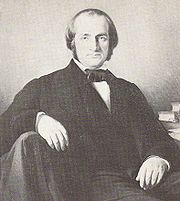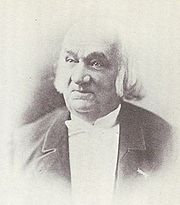
Constantin Heger
Encyclopedia

Belgium
Belgium , officially the Kingdom of Belgium, is a federal state in Western Europe. It is a founding member of the European Union and hosts the EU's headquarters, and those of several other major international organisations such as NATO.Belgium is also a member of, or affiliated to, many...
teacher of the Victorian era
Victorian era
The Victorian era of British history was the period of Queen Victoria's reign from 20 June 1837 until her death on 22 January 1901. It was a long period of peace, prosperity, refined sensibilities and national self-confidence...
. He is best remembered today for his association with Emily
Emily Brontë
Emily Jane Brontë 30 July 1818 – 19 December 1848) was an English novelist and poet, best remembered for her only novel, Wuthering Heights, now considered a classic of English literature. Emily was the third eldest of the four surviving Brontë siblings, between the youngest Anne and her brother...
and Charlotte Brontë
Charlotte Brontë
Charlotte Brontë was an English novelist and poet, the eldest of the three Brontë sisters who survived into adulthood, whose novels are English literature standards...
during the 1840s.
Early life
Héger was born in BrusselsBrussels
Brussels , officially the Brussels Region or Brussels-Capital Region , is the capital of Belgium and the de facto capital of the European Union...
and moved to Paris in 1825 in search of employment. For a period he worked as secretary to a solicitor
Solicitor
Solicitors are lawyers who traditionally deal with any legal matter including conducting proceedings in courts. In the United Kingdom, a few Australian states and the Republic of Ireland, the legal profession is split between solicitors and barristers , and a lawyer will usually only hold one title...
, but because of a shortage of funds, was unable to pursue a legal career himself. In 1829, he returned to Brussels, where he became a teacher of French and mathematics at the Athénée Royale. In 1830, he married his first wife, Marie-Josephine Noyer. When revolution broke out in Brussels
Belgian Revolution
The Belgian Revolution was the conflict which led to the secession of the Southern provinces from the United Kingdom of the Netherlands and established an independent Kingdom of Belgium....
, Héger fought on the barricades from 23 to 27 September on the side of the nationalists. In September 1833, Héger's wife died during a cholera
Cholera
Cholera is an infection of the small intestine that is caused by the bacterium Vibrio cholerae. The main symptoms are profuse watery diarrhea and vomiting. Transmission occurs primarily by drinking or eating water or food that has been contaminated by the diarrhea of an infected person or the feces...
epidemic. His son, Gustave died in June 1834, only 9 months old.
He was appointed a teacher in languages, mathematics, geography and Belgian history at the veterinary college in Brussels' Rue Terarken. He continued to teach at the Athénée Royale when it relocated to the Rue des Douze Apôtres in 1839. Héger met Mlle Claire Zoë Parent (1804 – 1887), the directress of the neighbouring girls’ boarding school in the Rue Isabelle, where he began teaching. They married in 1836 and had six children.
The Brontës
In 1842 Emily and Charlotte Brontë travelled to Brussels to enroll in the boarding school run by Héger and his wife, Mme. Héger. Their aim was to improve their skills in languages. In return for board and tuition, Charlotte taught English and Emily taught music. Their time at the boarding school was cut short when Elizabeth BranwellElizabeth Branwell
Elizabeth Branwell was the aunt of the literary siblings Charlotte Brontë, Emily Brontë and Anne Brontë...
, their aunt, who joined the family after the death of their mother to look after the children, died of internal obstruction in October 1842. Charlotte returned alone to Brussels in January 1843 to take up a teaching post at the boarding school. Her second stay there was not a happy one; she became lonely, homesick, and deeply attached to Constantin Héger. She finally returned to the Parsonage
Rectory
A rectory is the residence, or former residence, of a rector, most often a Christian cleric, but in some cases an academic rector or other person with that title...
at Haworth
Haworth
Haworth is a rural village in the City of Bradford metropolitan borough of West Yorkshire, England. It is located amongst the Pennines, southwest of Keighley and west of Bradford. The surrounding areas include Oakworth and Oxenhope...
in January 1844 and later used her time at the boarding school as the inspiration for some of The Professor
The Professor (novel)
The Professor was the first novel by Charlotte Brontë. It was originally written before Jane Eyre and rejected by many publishing houses, but was eventually published posthumously in 1857 by approval of Arthur Bell Nicholls, who accepted the task of reviewing and editing of the novel.-Plot...
and Villette
Villette (novel)
Villette is a novel by Charlotte Brontë, published in 1853. After an unspecified family disaster, protagonist Lucy Snowe travels to the fictional city of Villette to teach at an all-girls school where she is unwillingly pulled into both adventure and romance...
.
The extent of Charlotte Brontë's feelings for Héger were not fully realised until 1913, when her letters to him were published for the first time. Héger had first shown them to Mrs. Gaskell
Elizabeth Gaskell
Elizabeth Cleghorn Gaskell, née Stevenson , often referred to simply as Mrs Gaskell, was a British novelist and short story writer during the Victorian era...
when she visited him in 1856 while researching her biography The Life of Charlotte Brontë
The Life of Charlotte Bronte
The Life of Charlotte Brontë is the posthumous biography of Charlotte Brontë by fellow novelist Elizabeth Gaskell. Although quite frank in many places, Gaskell suppressed details of Charlotte's love for Constantin Héger, a married man, on the grounds that it would be too great an affront to...
, but she concealed their true significance. These letters, referred to as the 'Héger Letters', had been ripped up at some stage by Héger, but his wife had retrieved the pieces from the wastepaper bin and had meticulously sewn them back together. Paul Héger, Constantin's son, and his sisters, gave these letters to the British Museum
British Museum
The British Museum is a museum of human history and culture in London. Its collections, which number more than seven million objects, are amongst the largest and most comprehensive in the world and originate from all continents, illustrating and documenting the story of human culture from its...
, and they were shortly after printed in The Times
The Times
The Times is a British daily national newspaper, first published in London in 1785 under the title The Daily Universal Register . The Times and its sister paper The Sunday Times are published by Times Newspapers Limited, a subsidiary since 1981 of News International...
newspaper.
Later years

Constantin Héger died in 1896, and was buried with his wife and their daughter Marie, who died in 1886, in Watermael-Boitsfort
Watermael-Boitsfort
Watermael-Boitsfort or Watermaal-Bosvoorde is one of the nineteen municipalities located in the Brussels-Capital Region in Belgium....
municipal cemetery, on the edge of the Forêt de Soignes
Sonian Forest
The Sonian Forest is a forest that lies across the south-eastern part of Brussels, Belgium.The forest lies in the Flemish municipalities of Sint-Genesius-Rode, Hoeilaart, Overijse and Tervuren, in Uccle, Watermael-Boitsfort, Auderghem and Woluwe-Saint-Pierre in the Brussels-Capital Region and in...
.

